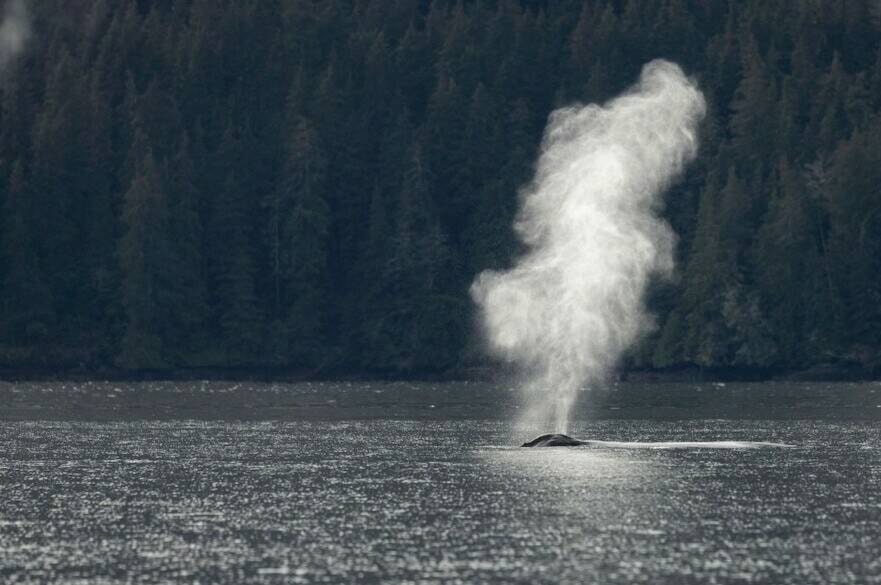Once upon a time primarily known as a “pulp mill town,” Port Alice is developing some renown for being a great place for whale watching.
For some in the village, the whales — particularly a what seems to be a rising number of humpbacks — have become delightful “noisy neighbours.”
Vince and Dayna Devlin, who live at Jeune Landing close to the shore of Neurotsos Inlet inlet, can hear and/or see them every morning. The whales also make an appearance at Quatsino Log Sort —Vince’s place of work — daily.
He noticed an increase in sightings about three or four years ago (about three years after the mill closure that happened in 2015) when they were “breaching all the time.” He says that he and his fellow workers saw them “play more then,” adding, “but I see them just coming cruising past more this year.”
Regan Hickling, owner of Rumble Beach Charters, has seen three species of whales in a single day. Approximately three years ago he came across grey whales migrating steadily for four or five hours while he was boating five or six miles offshore with a friend. They also came across some humpback whales and, later, Hickling saw an orca in front of his house.
Jackie Hildering, marine researcher and co-founder and director of Marine Education and Research Society who goes by the moniker, “the Marine Detective,” says that there is no way to determine if the return of humpbacks to the Port Alice area is related to the mill or not. She says there’s an increase generally along the coast.
Hildering adds that the whales are not territorial, that they just have strong site fidelity to where they have learned to feed.
“They generally come back to the same places to breed [warm water] and feed [cold water] year after year. This is what any good fisherman or fisherwoman would do.”
MERS actively catalogues and studies the local humpbacks. Observers identify the whales by their dorsal fins and by their tails, or “flukes.”
They are given an “official” name by the Canadian Pacific Humpback Collaboration, which is a series of numbers and letters that are not easy to remember. For better relatability, MERS gives the whales nicknames based on their distinguishing features.
Whale BCZ0220, has been given the name “Whiskers” by MERS because of a cat-like face on her tail.
“These nicknames allow for the potential for greater public engagement and thereby, conservation,” Hildering said. “The nicknames also really, really help us recognize the whales which is the foundation of all our other research.”
In 2019, Whiskers was spotted near Port Alice with a calf and another whale by photographer Darrell McIntosh. Hildering later held a video call with the students of Sea View School from her research vessel to get some ideas for nicknames for the these newest members of the Port Alice whale community.
With the Sea View School annual Terry Fox Run happening around that time, the students came up with the idea that BCX1100, the handicapped whale that was able to swim to Port Alice from Hawaii or Mexico, should be nicknamed “Terry” after Terry Fox and his Marathon of Hope.
The children then named Whiskers’ calf “Poseidon” because of a bright white marking on the calf’s fluke that looks like Poseidon’s trident.
Brenda Stevenson and her sisters, who arrived in Port Alice in 2017, can watch the whales from their kitchen window, even though they live a good distance up the hill in the Strata 2 condominiums.
“It just makes your heart sing. It just makes you feel good,” Stevenson said. “We come from the prairies: we see squirrels, we see deer, we see moose, lots of eagles, but you don’t see anything like that.”
For more information about the whales, whale research and supporting activities, visit mersociety.org.
— Debra Lynn
RELATED: Humpback comeback: More whales spotted in Salish Sea this year than any other
RELATED: ‘Absolutely gutting’: Mourning the death of Spike the humpback whale
Have a story tip? Email: editor@northislandgazette.com
Like us on Facebook and follow us on Twitter.
